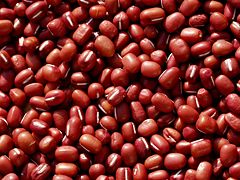Azuki bean
| Azuki bean | ||||||||||||||||||
|---|---|---|---|---|---|---|---|---|---|---|---|---|---|---|---|---|---|---|
 Azuki beans
|
||||||||||||||||||
| Scientific classification | ||||||||||||||||||
|
||||||||||||||||||
| Binomial name | ||||||||||||||||||
| Vigna angularis (Willd.) Ohwi & H. Ohashi |
The azuki bean (アズキ, also spelled adzuki or aduki) is an annual vine widely grown throughout East Asia and the Himalayas for its small (approximately 5 mm) bean. The cultivars most familiar in north-east Asia have a uniform red color, but white, black, gray and variously mottled varieties are also known. Scientists presume Vigna angularis var. nipponensis is the progenitor. Genetic evidence indicates that the azuki bean was first domesticated in the Himalayas. It was cultivated in China and Korea before 1000 BC. It was later taken to Japan, where it is now the second most popular legume after the soybean.[1]
Contents |
Names
The name azuki is a transliteration of the native Japanese name. Japanese also has a Chinese loanword, Shōzu (小豆), which means "small bean" (its counterpart "large bean" (大豆; Daizu) being the soybean). It is common to write 小豆 in kanji but pronounce it as azuki listen.
In China, the corresponding name (Chinese: 小豆; pinyin: xiǎodòu) is still used in botanical or agricultural parlance. However in everyday Chinese, the more common word is hongdou (紅豆; hóngdòu), meaning "red bean", because almost all Chinese cultivars are uniformly red. In English-language discussions of Chinese topics, the term "red bean" is often used (especially in reference to red bean paste), but in other contexts this usage can cause confusion with other beans that are also red. The Korean name is pat (hangul: 팥), and in Vietnamese it is called đậu đỏ.
Uses
In East Asian cuisine the azuki bean is commonly eaten sweetened. In particular, it is often boiled with sugar, resulting in red bean paste (an), a very common ingredient in all of these cuisines; it is also common to add flavoring to the bean paste, such as chestnut.

Red bean paste is used in many Chinese foods, such as tangyuan, zongzi, mooncakes, baozi, and red bean ice. It is also used as a filling for Japanese sweets such as anmitsu, taiyaki (Korean: bungeoppang), and daifuku. A more liquid version, using azuki beans boiled with sugar, lotus seeds, and orange peel, produces a sweet dish called red bean soup. Azuki beans are also commonly eaten sprouted, or boiled in a hot, tea-like drink. Some Asian cultures enjoy red bean paste as a filling or topping for various kinds of waffles, pastries, baked buns or biscuits.
In Japan, rice with azuki beans (赤飯; sekihan) is traditionally cooked for auspicious occasions. Azuki beans are also used to produce amanattō, and as a popular flavour of ice cream.
Azuki beans, along with butter and sugar, form the basis of the popular Somali supper dish cambuulo.
See also
- Red bean paste